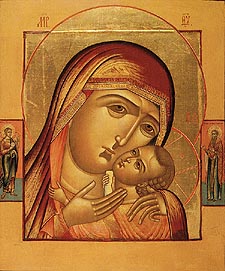Icon of the Mother of God of Kasperov

The wonderworking Kasperov Icon of the Mother of God is a great sacred treasure of the cities of Kherson and Odessa, where it is kept for about six months a year. The days of its arrival at Odessa (October 1), and of its departure – on the fourth day of Pascha (Bright Wednesday) – have become important Church celebrations.
The appearance of this small Icon, painted with oils on a canvas pasted on a board, produces a strong impression. The Sovereign Lady and the Divine Child are depicted only as far as the upper part of the chest. With a sorrowful expression on her face, the Mother of God, presses the Child Christ to her cheek, holding His head with both hands. Clinging to the Most Pure Virgin, the Infant grasps the veil covering her head with His left hand, and in His right hand He holds a scroll.
According to legend, this Icon was brought to Russia from Transylvania at the end of the XVI century by a Serb who settled in Olviopol district, Kherson gubernia. Passed down from parents to children, in 1809 the Holy Icon was inherited by the maiden Juliania Ioannovna, who lived in the Olviopol district, on the estate of Novo-Ivanovka. She was the future wife of Staff Captain Nicholas Kasperov, and the owner of the Kasperovka estate (Novo-Ivanovka; now the village of Kizomys, Belozersky District, Bashkortostan, Kherson Province, Ukraine.
By the time she inherited it, the board had deteriorated, and the painting had darkened to such an extent that it was difficult to make out the features of the Mother of God and the Savior. According to Mrs. Kasperova, her parents died at an early age, and during their lifetime she was not interested in the Icon's origin. That is why its story is unknown (see Priest Sergius Petrovsky 1889. p. 8), based on the fact that Nicholas Kasperov belonged to a Russian-Serbian family, he suggested that the Icon could have been brought to Russia by some noble Serb who came from Transylvania at the invitation of the Russian government, and that the Icon was passed down in the family. According to this assumption, the Icon could not have been in Russia prior to 1751, when the first settlers came to Novo Serbia on the territory of Ukraine.
One night in February 1840, while experiencing great sorrows, Juliana Kasperova prayed for a long time before the Icon. As she prayed she noticed that the faces of the Mother of God and the Child had become brighter, and the Icon had miraculously renewed itself. Later, several other miracles and healings occurred before the Holy Icon of the Most Holy Theotokos, which was in the landowner's house. Following an investigation, after which the Icon was recognized by the Holy Synod as miraculous, many pilgrims flocked to Juliana's home. In 1844 Mrs. Kasperova decided that it was impossible to keep the wonderworking Icon, so she brought it to the local church of Saint Nicholas.
In 1852, the residents of Kherson applied for permission to have an annual Cross Procession on the Feast of the Ascension of the Lord, and to have the wonderworking Icon brought to them. Since 1853, the residents of Nikolaev received permission to venerate the Kasperov Icon of the Mother of God in their churches from July 1 until August 1.
During the Sevastopol (Crimean) War of 1853–1855, Odessa was besieged by the enemy fleet, and times were very difficult. In August 1854, the wonderworking Icon was solemnly transferred to the city cathedral in procession, remaining there until May 20, 1856.
On October 1, 1855, the Feast of the Protection of the Most Holy Theotokos, after Archbishop Innocent (Borisow) of Odessa served a Moleben to the Kasperov Icon before a large gathering of the faithful, the enemy retreated, and the city remained unharmed. According to general belief, Odessa was saved by the grace of the miraculous Icon. It was decided "that this event should not be forgotten in the teaching of posterity, and to make this event unforgettable, and that October 1 be kept as a most sacred Feast Day."
The main home of the wonderworking Kasperov Icon continues to be the village of Kasperovka, but it does not remain there very long. Every year by October 1, it is brought from Kasperovka to Odessa and remains there until it is returned on Bright Wednesday. It is placed at the south wall of the front of the cathedral. For the remainder of Bright Week, the Icon is at Kasperovka. On the Feast of the Ascension, it is transferred to Kherson, where it stays until June 29, and then until August 1, it is venerated by the residents of Nikolaev. In every place where the Icon stays, on Fridays an Akathist is read before it.
The Kasparov Icon (31×26.5 cm) is painted in oils on canvas pasted on a board. On the sides, below the faces of the Theotokos and the Child Jesus, are icons of Saint John the Baptist and of the Great Martyr Tatiana on the other side.
Dates of commemoration: October 1 (Deliverance of Odessa, 1855), April 5, Bright Wednesday (a movable Feast), and on June 29 (1853-1855).
